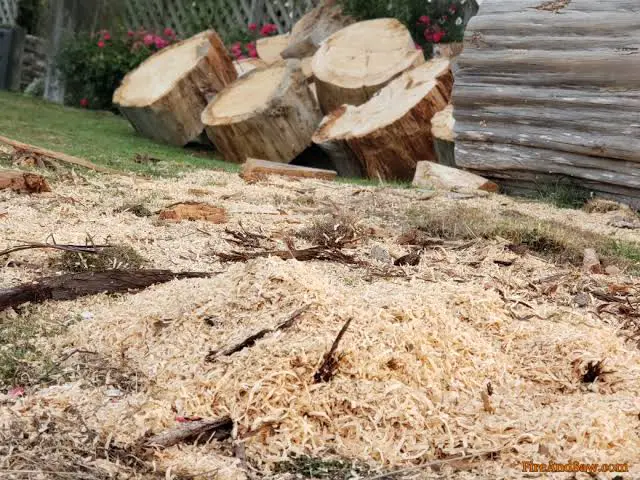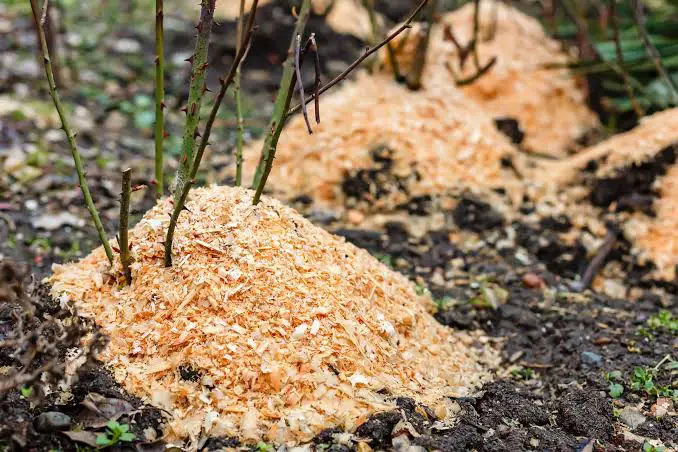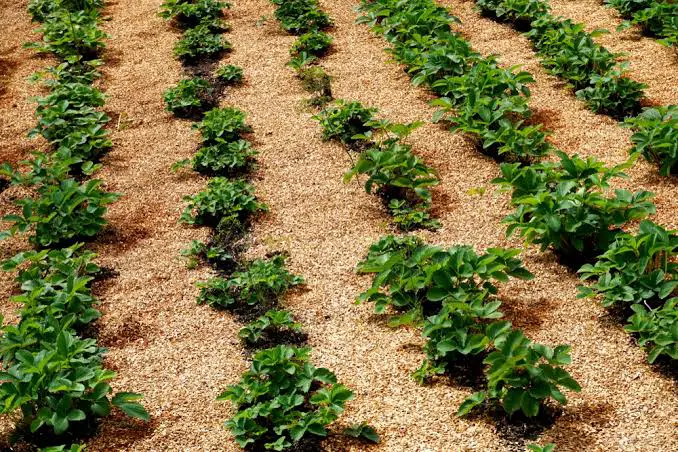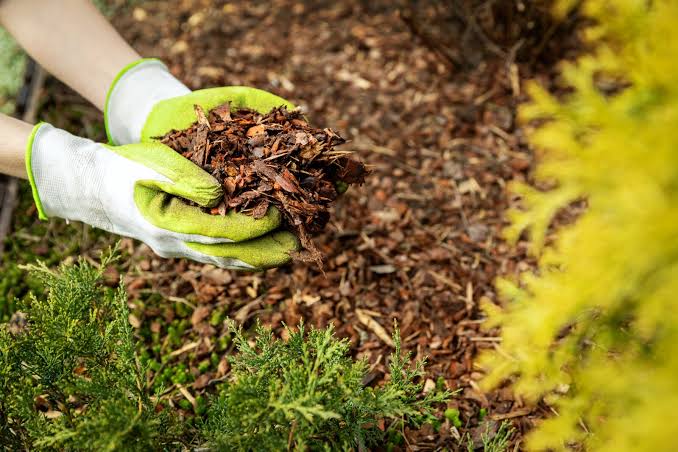Converting wood wastes into mulch is a great and cool idea that helps the soil to stay moist. Wood wastes are pieces of wood that are left over or no longer needed, instead of throwing away these wood wastes, we can turn them into something useful called mulch. Mulch is like a blanket for the soil, helping it stay moist, preventing weeds from growing, and keeping the soil from getting too hot or too cold. When we convert wood wastes into mulch, we are recycling and helping the environment.
Making mulch from wood wastes is easy. First, we collect the wood wastes, such as branches, twigs, and even old furniture. Then, we chop them into small pieces called wood chips. These wood chips are spread over the soil in gardens, parks, and other places where plants grow. As the mulch breaks down, it adds nutrients to the soil, making it healthier for plants to grow.
There are many benefits to using mulch made from wood wastes. One benefit is that it helps to conserve water. By covering the soil with mulch, less water evaporates, which means we don’t have to water our plants as often. Another benefit is that mulch helps to control weeds. Weeds are plants that grow where we don’t want them, and they can steal nutrients from our plants. Mulch blocks out sunlight, which stops weeds from growing.
Moreover, mulch made from wood wastes can improve the soil’s structure. Soil with mulch is softer and easier for plant roots to grow through. It also helps to prevent soil erosion, which is when soil is washed away by rain or wind. When soil erodes, it can cause problems for plants and the environment. Mulch acts like a barrier, keeping the soil in place.
Using mulch made from wood wastes is also good for the environment. Instead of sending wood wastes to the landfill, where they take up space and release greenhouse gases, we can recycle them into something beneficial. This reduces the amount of waste that ends up in landfills and helps to combat climate change.
Converting wood wastes into mulch is a simple and effective way to recycle and improve our environment. By turning something that might be considered trash into a valuable resource, we can conserve water, control weeds, improve soil health, and reduce waste. It’s a win-win solution for both plants and the planet.
Read Also: Waste to Energy Business: What You Need to Know
Types of Recyclable Wood Wastes and their Uses

Wood wastes come in various forms, and each type can be recycled and repurposed in different ways to benefit the environment and society. Here are some common types of recyclable wood wastes and their uses:
1. Sawdust:
Uses: Sawdust can be compressed into wood pellets for fuel, used as animal bedding, or mixed with other materials to make composite wood products like particleboard or MDF (medium-density fiberboard). It can also be added to compost piles to improve aeration and absorb moisture.
2. Wood Chips and Shavings:
Uses: Wood chips and shavings are commonly used as mulch in gardens, parks, and landscaping projects to retain moisture, suppress weeds, and improve soil health. They can also be used in animal bedding, particularly for poultry and livestock.
3. Wooden Pallets and Crates:
Uses: Old wooden pallets and crates can be repaired and reused, or disassembled and the wood repurposed for various DIY projects such as furniture making, crafting, or building structures like raised beds or compost bins. They can also be ground down into wood chips for mulch or other wood-based products.
4. Construction and Demolition Waste:
Uses: Wood from construction and demolition projects, such as framing lumber, plywood, and trim, can be salvaged and reused in new construction or renovation projects. It can also be recycled into mulch, wood chips, or biomass fuel.
5. Furniture and Cabinetry:
Uses: Old or damaged furniture and cabinetry can be refurbished, repaired, or repurposed. Salvageable wood can be used for DIY projects or donated to organizations that refurbish and sell used furniture. Unsalvageable pieces can be dismantled and the wood recycled into new products or biomass fuel.
6. Tree Trimmings and Branches:
Uses: Tree trimmings and branches can be chipped or shredded into mulch for landscaping purposes. They can also be processed into wood chips for use in biomass energy production or composted to create organic fertilizer.
7. Wooden Packaging Material:
Uses: Wooden packaging materials like crates, pallets, and shipping containers can be repaired and reused multiple times. Once they reach the end of their lifespan, they can be recycled into mulch, wood chips, or other wood-based products.
Additionally, recycling wood wastes helps to mitigate greenhouse gas emissions associated with deforestation and landfill decomposition, contributing to a more sustainable and environmentally friendly society.
How to Convert Wood Wastes into Mulch

Converting wood wastes into mulch is a straightforward process that can be done using basic tools and equipment. Here’s a simple guide on how to do it:
1. Gather Wood Wastes: Collect wood wastes such as branches, twigs, bark, and other small pieces of wood. You can also use sawdust, wood chips, and shavings if available.
2. Prepare the Area: Choose a suitable area for the mulch-making process. Ideally, it should be outdoors with good ventilation to prevent dust buildup. Lay down a tarp or a large sheet of plastic to catch the wood chips and make cleanup easier.
3. Shred or Chip the Wood: If the wood wastes are in large pieces, use a wood chipper or shredder to break them down into smaller pieces. Alternatively, you can use a chainsaw, axe, or handsaw to manually chop the wood into smaller chunks. The size of the wood chips will depend on your preference and the intended use of the mulch.
If desired, you can mix the wood chips with compost or other soil amendments to enhance the nutrient content of the mulch. This is especially beneficial if you plan to use the mulch for gardening or landscaping purposes.
4. Spread the Mulch: Once you have a sufficient amount of wood chips, spread them evenly over the soil surface in the area you wish to mulch. Aim for a layer of mulch that is about 2-4 inches thick. Make sure to leave some space around the base of plants and trees to prevent rot and allow for proper airflow.
5. Water the Mulch: After spreading the mulch, lightly water it to help settle the wood chips and promote decomposition. This will also help prevent the mulch from blowing away in windy conditions.
6. Monitor and Maintain: Over time, the wood chips will break down and decompose, adding organic matter to the soil and improving its structure. Periodically check the mulch layer and add more wood chips as needed to maintain the desired thickness.
7. Replenish as Needed: As the mulch decomposes, it will need to be replenished periodically. Simply add fresh wood chips on top of the existing mulch layer to maintain its effectiveness.
The Benefits of Converting Wood Wastes into Mulch
Converting wood wastes into mulch offers numerous benefits for both the environment and gardeners. Here are some of the key advantages:
1. Soil Health Improvement: Mulch made from wood wastes enriches the soil as it decomposes, releasing nutrients such as nitrogen, potassium, and phosphorus. This enhances soil fertility and promotes healthier plant growth.
2. Moisture Retention: Wood mulch acts as a protective barrier, reducing moisture evaporation from the soil surface. This helps to maintain consistent soil moisture levels, reducing the need for frequent watering and conserving water resources.
3. Weed Suppression: A layer of wood mulch inhibits weed germination and growth by blocking sunlight from reaching weed seeds. This reduces the competition for nutrients and space, allowing cultivated plants to thrive without the interference of invasive weeds.
4. Temperature Regulation: Mulch moderates soil temperatures by insulating the soil from extreme heat in summer and cold in winter. This creates a more stable environment for plant roots, minimizing stress and improving overall plant health.
5. Erosion Prevention: Mulch helps to prevent soil erosion by reducing the impact of rainfall and wind on the soil surface. It holds soil particles in place, preventing them from being washed away and protecting against the loss of valuable topsoil.
6. Improved Aeration and Drainage: As wood mulch decomposes, it creates air pockets in the soil, promoting better aeration and drainage. This prevents soil compaction and waterlogging, allowing roots to penetrate deeper and access nutrients more effectively.
7. Enhanced Microbial Activity: Wood mulch provides a habitat for beneficial microorganisms such as bacteria, fungi, and earthworms. These organisms break down organic matter, further enriching the soil and improving its overall structure and fertility.
8. Longevity and Cost-Effectiveness: Mulch made from wood wastes is long-lasting and cost-effective compared to other mulch materials. It requires less frequent replacement, saving time and money in the long run.
9. Environmental Sustainability: By recycling wood wastes into mulch, we reduce the amount of organic material sent to landfills, where it would decompose and produce methane, a potent greenhouse gas. Mulching also promotes sustainable land management practices and supports a healthy ecosystem.
Overall, converting wood wastes into mulch offers a range of benefits that contribute to healthier soils, more productive gardens, and a greener, more sustainable environment. It’s a simple yet effective way to harness the potential of organic waste and improve the health and vitality of our landscapes.
Read Also: Practical Steps to Convert Asphalt Wastes into Aggregate for New Construction
The Uses and Benefits of Recycled Mulch

Recycled mulch, derived from various sources including wood wastes, offers a multitude of uses and benefits for landscaping, gardening, and environmental conservation. Here’s a look at some of its primary uses and the advantages it provides:
Uses:
1. Gardening: Recycled mulch is commonly used in gardens to suppress weeds, retain moisture, regulate soil temperature, and improve soil health. It provides a protective layer over the soil, reducing erosion and creating a conducive environment for plant growth.
2. Landscaping: In landscaping projects, recycled mulch serves as an attractive and functional ground cover. It can be used around trees, shrubs, flower beds, and pathways to enhance aesthetics, define borders, and create a uniform appearance in outdoor spaces.
3. Erosion Control: Recycled mulch is effective in preventing soil erosion on slopes, embankments, and other areas prone to runoff. By absorbing rainwater and reducing surface runoff, it helps stabilize the soil and protect against erosion caused by wind and water.
4. Playground Surfacing: In playgrounds and recreational areas, recycled rubber mulch provides a safe and cushioned surface for children to play on. It helps absorb impact from falls and reduces the risk of injuries, making it an ideal choice for playground surfacing materials.
5. Soil Amendment: Recycled organic mulch enriches the soil as it decomposes, adding valuable nutrients and organic matter to improve soil structure and fertility. It enhances microbial activity and promotes healthier root development, leading to stronger, more resilient plants.
6. Water Conservation: By reducing moisture evaporation from the soil surface, recycled mulch helps conserve water in landscaping and gardening applications. This is especially beneficial in arid regions or during periods of drought, where water conservation is a priority.
Benefits:
1. Weed Suppression: A layer of recycled mulch acts as a natural weed barrier, inhibiting the germination and growth of unwanted plants by blocking sunlight and preventing weed seeds from reaching the soil.
2. Moisture Retention: Recycled mulch helps maintain soil moisture levels by reducing water evaporation from the soil surface. This minimizes the need for frequent watering and helps plants survive dry spells and hot weather conditions.
3. Temperature Regulation: Recycled mulch insulates the soil, moderating temperature fluctuations and protecting plant roots from extreme heat in summer and cold in winter. This creates a more stable growing environment and reduces stress on plants.
4. Soil Health Improvement: As recycled mulch decomposes, it adds organic matter to the soil, enhancing its fertility, structure, and biological activity. It encourages the growth of beneficial microorganisms and earthworms, leading to healthier, more productive soils.
5. Erosion Control: Recycled mulch helps prevent soil erosion by reducing the impact of rainfall and runoff on the soil surface. It stabilizes the soil, prevents sediment loss, and protects against erosion caused by wind and water.
6. Resource Conservation: Using recycled mulch diverts organic waste from landfills and reduces the need for virgin materials, conserving natural resources and minimizing environmental impact. It supports a circular economy by repurposing waste materials into valuable resources for landscaping and gardening.
Recycled mulch offers a wide range of uses and benefits, making it a versatile and sustainable option for landscaping, gardening, and soil conservation efforts. Whether used to beautify outdoor spaces, improve soil health, or protect against erosion, recycled mulch plays a valuable role in promoting environmental sustainability and enhancing the functionality and aesthetics of landscapes.
The Challenges of Converting Wood Wastes into Mulch and their Solutions
While converting wood wastes into mulch offers numerous benefits, there are also some challenges associated with the process. Here are some common challenges and their corresponding solutions:
1. Size and Processing:
Challenge: Wood wastes come in various sizes and shapes, requiring processing to achieve the desired mulch consistency.
Solution: Invest in appropriate equipment such as wood chippers or shredders to efficiently process wood wastes into uniform-sized mulch particles. Adjust settings to accommodate different wood waste sizes and types.
2. Contamination and Impurities:
Challenge: Wood wastes may contain contaminants such as nails, staples, or treated wood, which can damage mulching equipment or pose safety hazards.
Solution: Implement strict sorting and inspection procedures to remove contaminants from wood waste streams before processing. Educate suppliers and workers on proper waste segregation practices to minimize contamination.
3. Seasonal Availability and Storage:
Challenge: Wood wastes may be more readily available during certain seasons, requiring proper storage and preservation to maintain quality and supply consistency.
Solution: Develop storage facilities or systems to stockpile wood wastes during peak seasons for use throughout the year. Implement measures to protect stored materials from moisture, pests, and deterioration.
4. Transportation and Logistics:
Challenge: Transporting large volumes of wood wastes to processing facilities or end-users can be logistically challenging and costly.
Solution: Optimize transportation routes and logistics to minimize costs and environmental impact. Consider establishing regional processing centers or partnering with local businesses to reduce transportation distances.
5. Economic Viability and Market Demand:
Challenge: The economic viability of converting wood wastes into mulch depends on market demand, pricing fluctuations, and competition from alternative mulch materials.
Solution: Conduct market research to assess demand trends, pricing dynamics, and competitive landscape. Diversify product offerings and target niche markets to mitigate risks and maximize profitability.
6. Environmental and Regulatory Compliance:
Challenge: Converting wood wastes into mulch may raise environmental and regulatory concerns related to air and water pollution, waste management, and land use.
Solution: Implement best practices and technologies to minimize environmental impacts and comply with regulatory requirements. Invest in pollution control measures, waste recycling programs, and sustainable land management practices.
7. Public Perception and Acceptance:
Challenge: Public perception and acceptance of recycled wood mulch may vary depending on factors such as aesthetics, performance, and safety concerns.
Solution: Educate consumers and stakeholders about the benefits of recycled wood mulch, including its environmental sustainability, cost-effectiveness, and performance advantages. Address concerns through transparent communication, product testing, and quality assurance measures.
Collaboration among industry players, government agencies, and community stakeholders is essential to drive innovation, improve efficiency, and promote the widespread adoption of recycled wood mulch solutions.
Frequently Asked Questions (FAQs) About How to Convert Wood Wastes into Mulch
1. Q: What types of wood wastes can be used to make mulch?
A: Various types of wood wastes can be used, including branches, twigs, sawdust, wood chips, pallets, crates, construction waste, and old furniture.
2. Q: Do I need special equipment to convert wood wastes into mulch?
A: While specialized equipment such as wood chippers or shredders can make the process more efficient, basic tools like axes, saws, and hammers can also be used to manually chop or break down wood wastes.
3. Q: How small should I chop the wood wastes for mulch?
A: The size of the wood chips or pieces depends on personal preference and intended use. Generally, smaller pieces decompose faster and are easier to spread, but larger pieces may provide better weed suppression and insulation.
4. Q: Can I use treated or painted wood for mulch?
A: It’s best to avoid using treated or painted wood for mulch, as the chemicals and toxins in these materials can leach into the soil and harm plants. Stick to untreated, natural wood wastes for mulching purposes.
5. Q: How thick should I spread the mulch over the soil?
A: Aim for a mulch layer that is about 2-4 inches thick. Avoid piling mulch too close to plant stems or tree trunks, as it can cause rot and encourage pests and diseases.
6. Q: How often should I replenish the mulch?
A: Mulch will decompose over time, so it’s important to replenish it periodically to maintain the desired thickness. This may vary depending on factors such as climate, soil conditions, and the type of wood mulch used.
7. Q: Can I use recycled wood mulch in vegetable gardens?
A: Yes, recycled wood mulch can be used in vegetable gardens, but it’s important to use untreated wood and avoid mulch containing any contaminants that may be harmful to edible plants.
8. Q: Will wood mulch attract termites or other pests?
A: While termites are attracted to wood, properly processed and aged wood mulch is less likely to attract pests. To minimize the risk, avoid using fresh wood mulch and maintain proper mulch thickness and placement.
9. Q: Is wood mulch flammable?
A: Wood mulch is combustible and can pose a fire hazard, especially in dry conditions. To reduce the risk of fire, keep mulch moist and clear away any debris or vegetation that could ignite.
10. Q: Can I compost wood mulch?
A: Yes, wood mulch can be composted, but it will take longer to break down compared to other organic materials. Use shredded or finely chopped wood mulch and mix it with other compostable materials to accelerate decomposition.
Read Also: Wild Dog Description, their Personality and Care Guide

